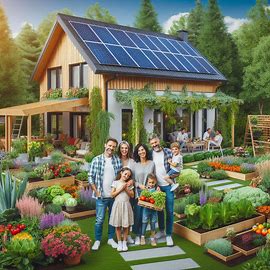
Introduction
Creating a sustainable, environmentally conscious home is more important than ever. Eco-friendly home improvement ideas not only help protect the planet but also reduce energy bills and improve your quality of life. This comprehensive guide explores practical and innovative ways to make your home greener.
1. Energy Efficiency Upgrades
1.1 Install Energy-Efficient Windows
Energy-efficient windows play a vital role in reducing heat loss and gain. Double or triple-glazed windows with low-emissivity coatings are excellent choices. They provide insulation, reduce energy consumption, and enhance comfort.
Benefits:
- Lower energy bills
- Increased indoor comfort
- Improved noise insulation
Tip: Look for ENERGY STAR-rated windows for maximum efficiency.
1.2 Upgrade to LED Lighting
LED lights consume up to 90% less energy than traditional incandescent bulbs and last significantly longer. Replacing your home’s lighting with LEDs is a quick and cost-effective eco-friendly home improvement idea.
Advantages:
- Lower electricity usage
- Longer lifespan (up to 25,000 hours)
- Variety of colors and styles
Example: Replacing 20 incandescent bulbs with LED alternatives can save over $200 annually in energy costs.
1.3 Use Smart Thermostats
Smart thermostats learn your habits and optimize heating and cooling schedules to reduce energy use. Models like Nest or Ecobee can be controlled remotely and provide detailed energy reports.
Key Features:
- Remote control via smartphone
- Scheduling and automation
- Energy-saving suggestions
Stat: Homes using smart thermostats can reduce energy bills by up to 10-12% on heating and 15% on cooling.
2. Water Conservation Techniques
2.1 Install Low-Flow Fixtures
Low-flow showerheads and faucets reduce water usage without sacrificing performance. These fixtures can save thousands of gallons annually.
Benefits:
- Reduces water waste
- Lowers water bills
- Supports sustainable living
Example Table:
| Fixture Type | Traditional Flow | Low-Flow Rate | Savings |
|---|---|---|---|
| Showerhead | 2.5 GPM | 1.5 GPM | ~40% |
| Faucet | 2.2 GPM | 1.0 GPM | ~55% |
2.2 Use Dual-Flush Toilets
Dual-flush toilets offer two flush options: a low-volume flush for liquid waste and a higher-volume flush for solid waste. They can reduce water use by more than 50%.
Features:
- Saves up to 68% more water than conventional toilets
- Easy to install and maintain
- Modern designs available
2.3 Install a Greywater System
Greywater systems reuse water from sinks, showers, and laundry for irrigation. This significantly reduces fresh water demand.
Considerations:
- Requires professional installation
- Best for areas with water restrictions
- Improves garden sustainability
3. Sustainable Building Materials
3.1 Use Recycled and Reclaimed Materials
Incorporating recycled or reclaimed materials into your home reduces environmental impact and adds character.
Common Options:
- Reclaimed wood for flooring or furniture
- Recycled metal roofing
- Repurposed bricks or tiles
Pros:
- Lowers demand for new resources
- Often more durable
- Unique aesthetic appeal
3.2 Opt for Bamboo or Cork Flooring
Both bamboo and cork are renewable resources that make for stylish, eco-friendly flooring.
Comparison Table:
| Material | Renewability | Durability | Cost | Maintenance |
| Bamboo | High | High | $$ | Low |
| Cork | High | Moderate | $$ | Moderate |
3.3 Use Low-VOC Paints and Finishes
Volatile organic compounds (VOCs) in paints and finishes contribute to indoor air pollution. Low-VOC or no-VOC products are healthier for both people and the environment.
Advantages:
- Improved indoor air quality
- Reduced health risks
- Safer for children and pets
Tip: Look for GREENGUARD or Green Seal certifications.
4. Renewable Energy Options
4.1 Install Solar Panels
Solar panels are a cornerstone of any green home. They convert sunlight into electricity, reducing reliance on fossil fuels.
Benefits:
- Significant energy savings
- Tax incentives and rebates
- Increases home value
Consideration: The average cost of installation varies by location and system size, but long-term savings often offset the upfront investment.
4.2 Use Solar Water Heaters
Solar water heaters use the sun’s energy to heat water for household use. They’re more efficient than traditional electric or gas systems.
Features:
- Lower utility bills
- Minimal maintenance
- Suitable for sunny climates
4.3 Invest in Wind or Geothermal Energy
While less common, wind turbines and geothermal systems offer powerful renewable energy solutions for rural or open properties.
Pros of Geothermal Systems:
- Extremely efficient
- Long lifespan
- Quiet operation
5. Eco-Friendly Landscaping
5.1 Create a Native Garden
Native plants are adapted to local conditions and require less water and maintenance.
Advantages:
- Supports local wildlife
- Reduces irrigation needs
- Enhances biodiversity
Example Plants by Region:
- Southwest US: Desert Marigold, Agave
- Northeast US: Black-eyed Susan, Wild Bergamot
5.2 Install a Rainwater Harvesting System
Rain barrels or underground cisterns collect and store rainwater for landscaping.
Benefits:
- Conserves water
- Reduces runoff
- Easy to maintain
5.3 Use Permeable Paving
Permeable paving materials allow water to seep through, reducing runoff and recharging groundwater.
Materials Include:
- Gravel
- Porous asphalt
- Interlocking pavers
Environmental Impact:
- Improves stormwater management
- Reduces heat island effect
Conclusion: Start Greening Your Home Today
Adopting eco-friendly home improvement ideas is an impactful way to contribute to environmental preservation and create a healthier living space. Whether it’s installing solar panels, upgrading to low-flow fixtures, or planting native gardens, every small change adds up.
Get Involved:
- Share your eco-renovation stories with friends or on social media.
- Join local sustainability initiatives.
- Encourage others to embrace greener living.
Transform your home into a model of sustainability—start today, and build a better tomorrow.